The Strategies to Develop Bilingual Ability for Vietnamese
The hypothesis is that non-native language speakers (e.g., Vietnamese who study English) face lots of difficulties
due to the differences in linguistic features and negative transference. Therefore, no one can deny that it is not easy to study a
language and more difficult to study a second language or a foreign language now that every language in the world has its own
characteristics which are nearly completely different from one another. To solve this problem, many linguists have created their
theories of second language acquisition, such as Behaviorist's theory, Nativist's theory, Interactionist's theory, Information
Processing theory, Vygotsky's theory, Halliday's theory, Sociolinguistic's theory. Therefore, with the hope to solve those
problems, this study focuses on some difficulties facing learners of English and their solutions. The article is divided into 3
main parts, including difficulties in the four skills as (1) speaking and listening for communication such as prosody and
fluency; (2) writing and (3) reading. About the solutions for the difficulties mentioned above, to begin with, in prosody,
solution focuses on the importance of combining phonological knowledge with rhythm, melody, English stress rules and
syntax rules in teaching and learning English intonation affected by stress for Vietnamese students, verified by Experimental
Phonetics. Moreover, writing, grammar and vocabularies improving as well as identification of the types of writing can be
considered as one of the practical solutions. Last but not least, in reading, K-W-L strategy (K: KNOWN, W: WHAT, L:
LEARNT), one the best ways to activate schemata is also the suitable solutions as well
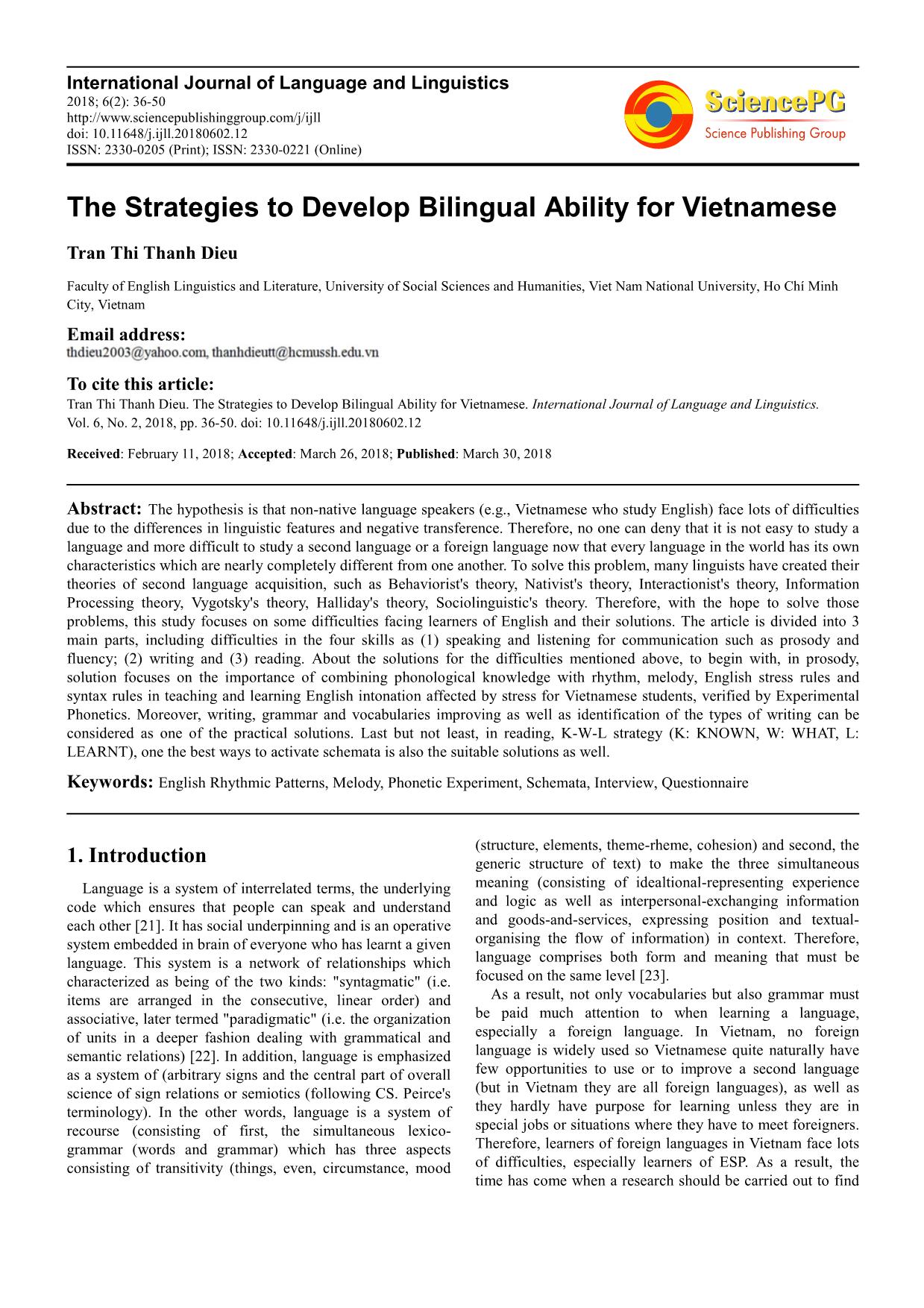
Trang 1
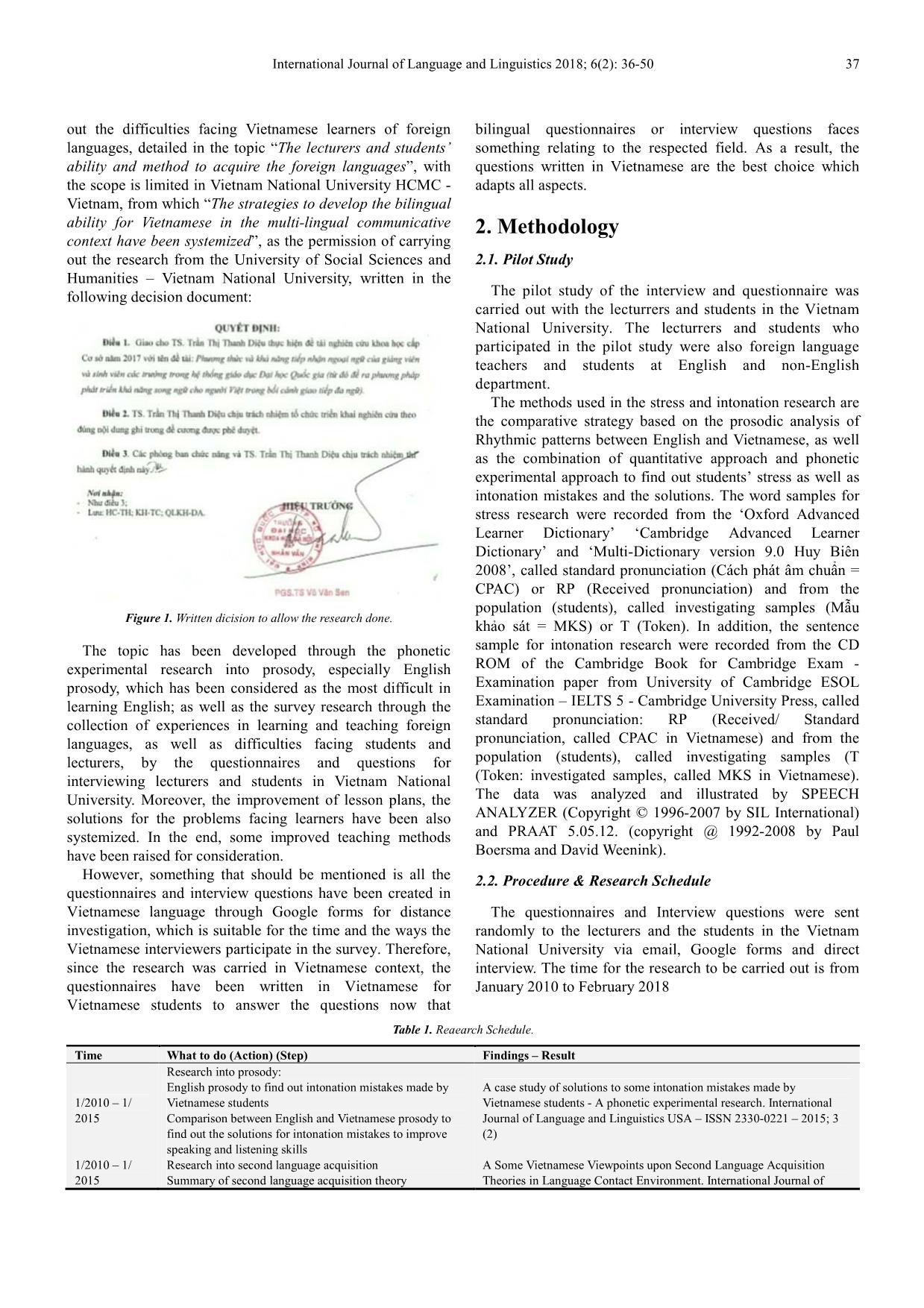
Trang 2
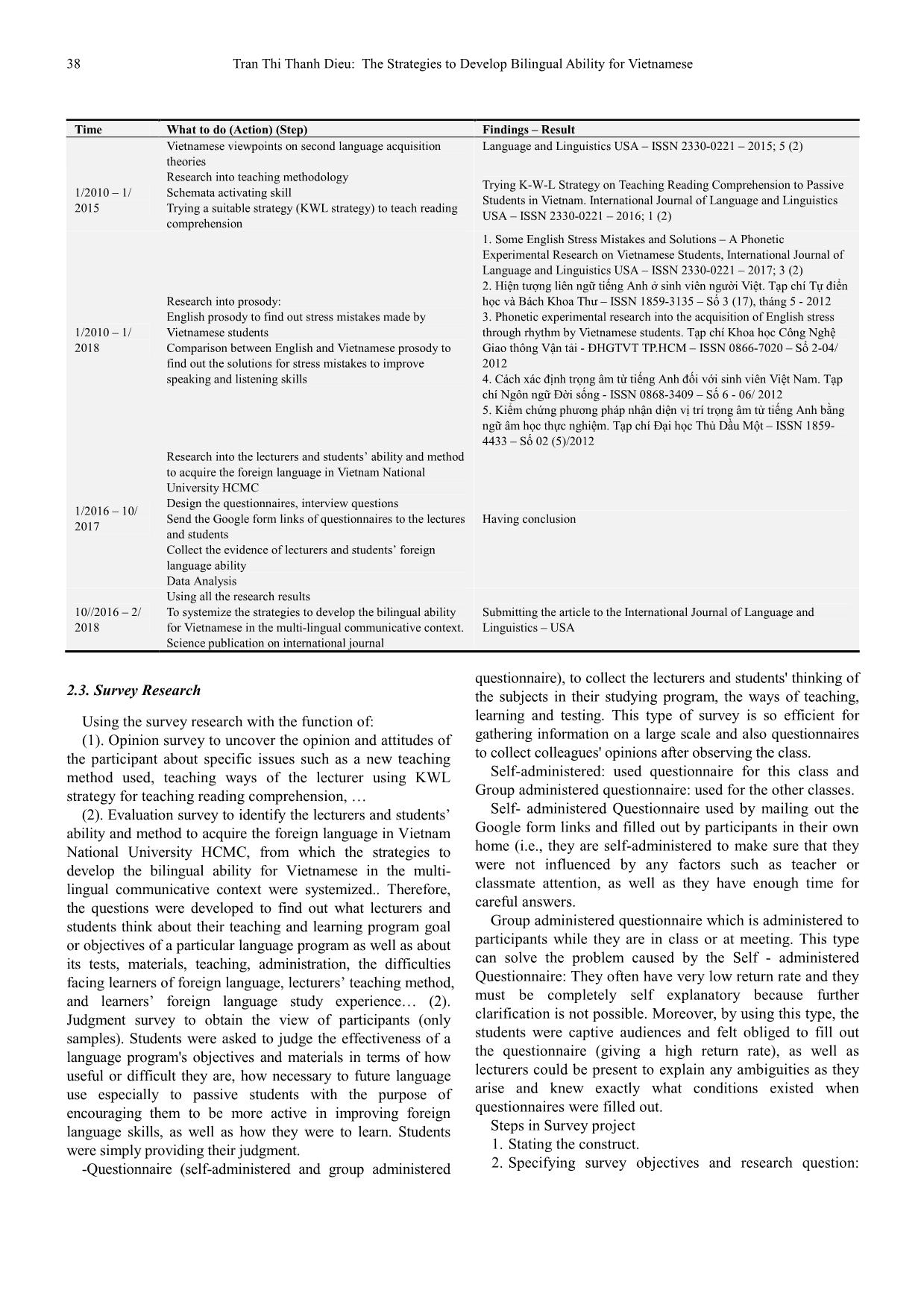
Trang 3
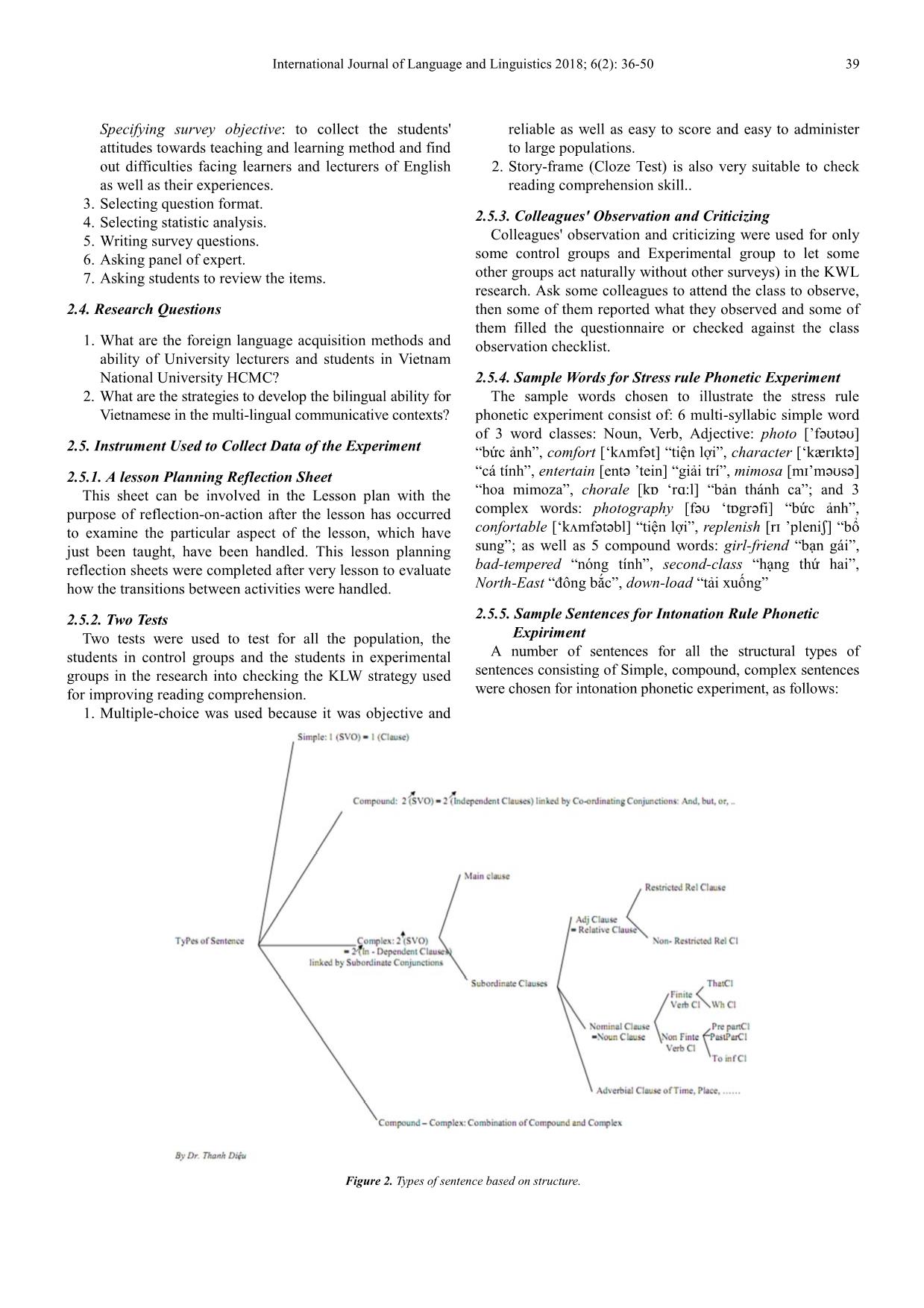
Trang 4
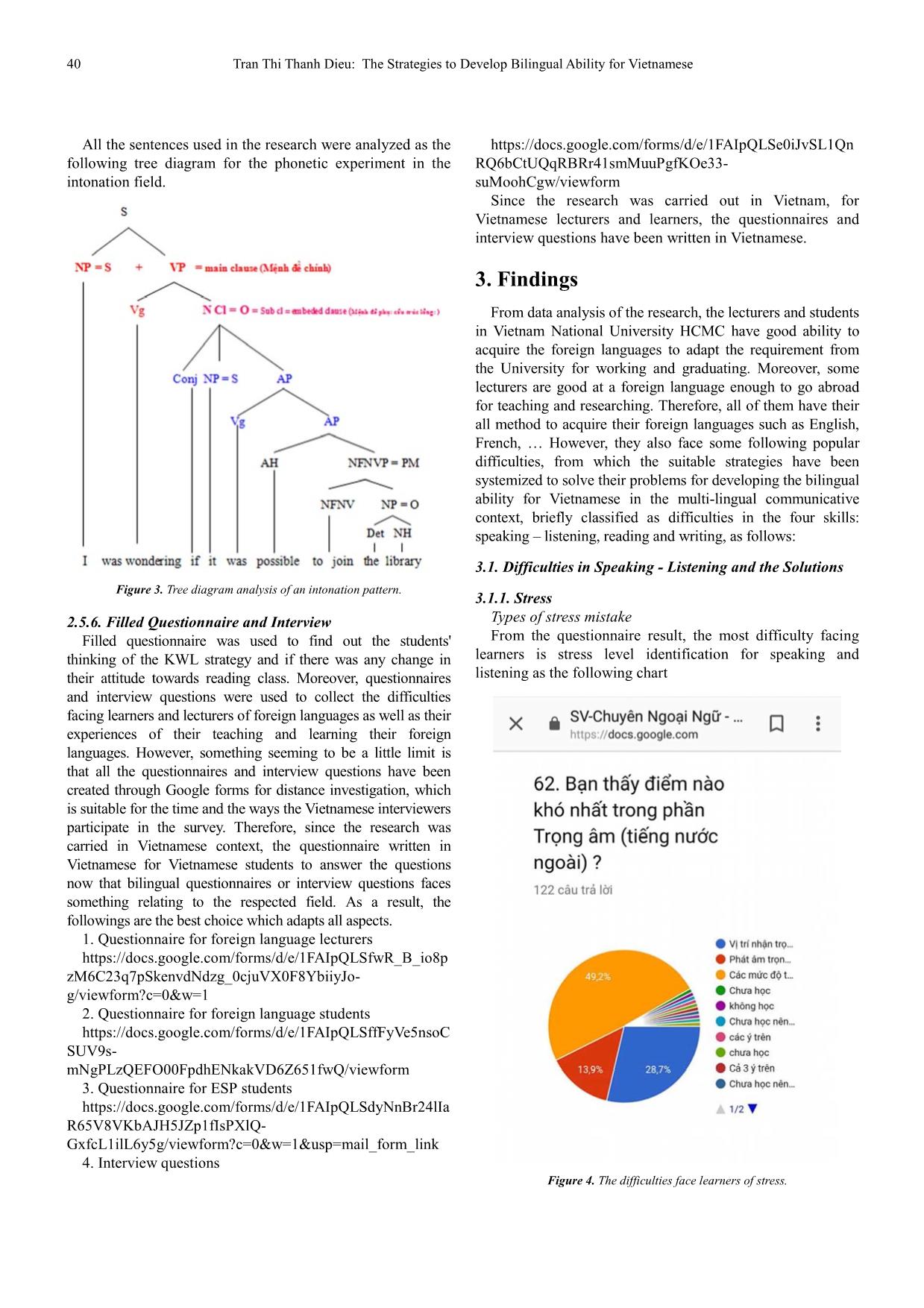
Trang 5
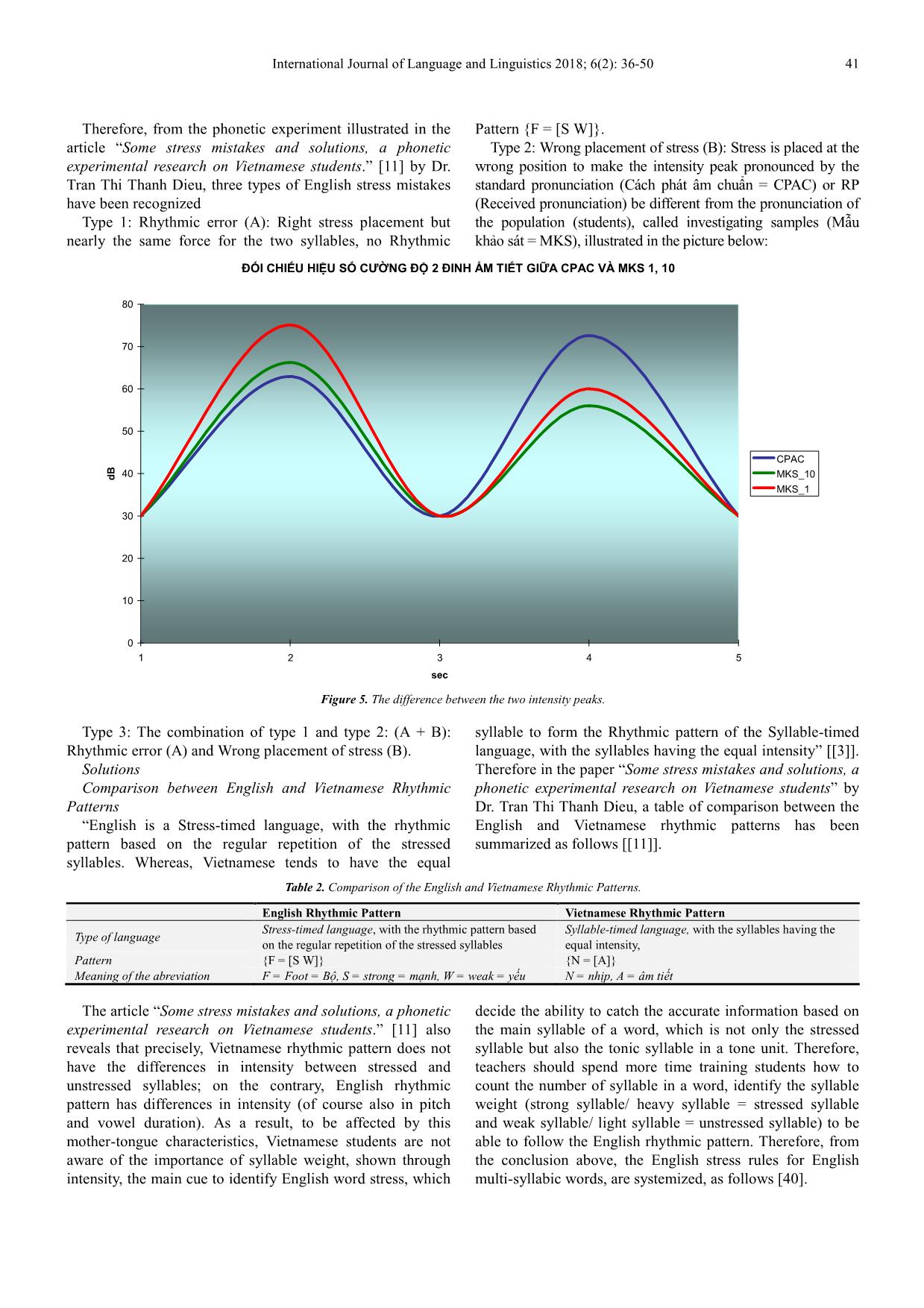
Trang 6
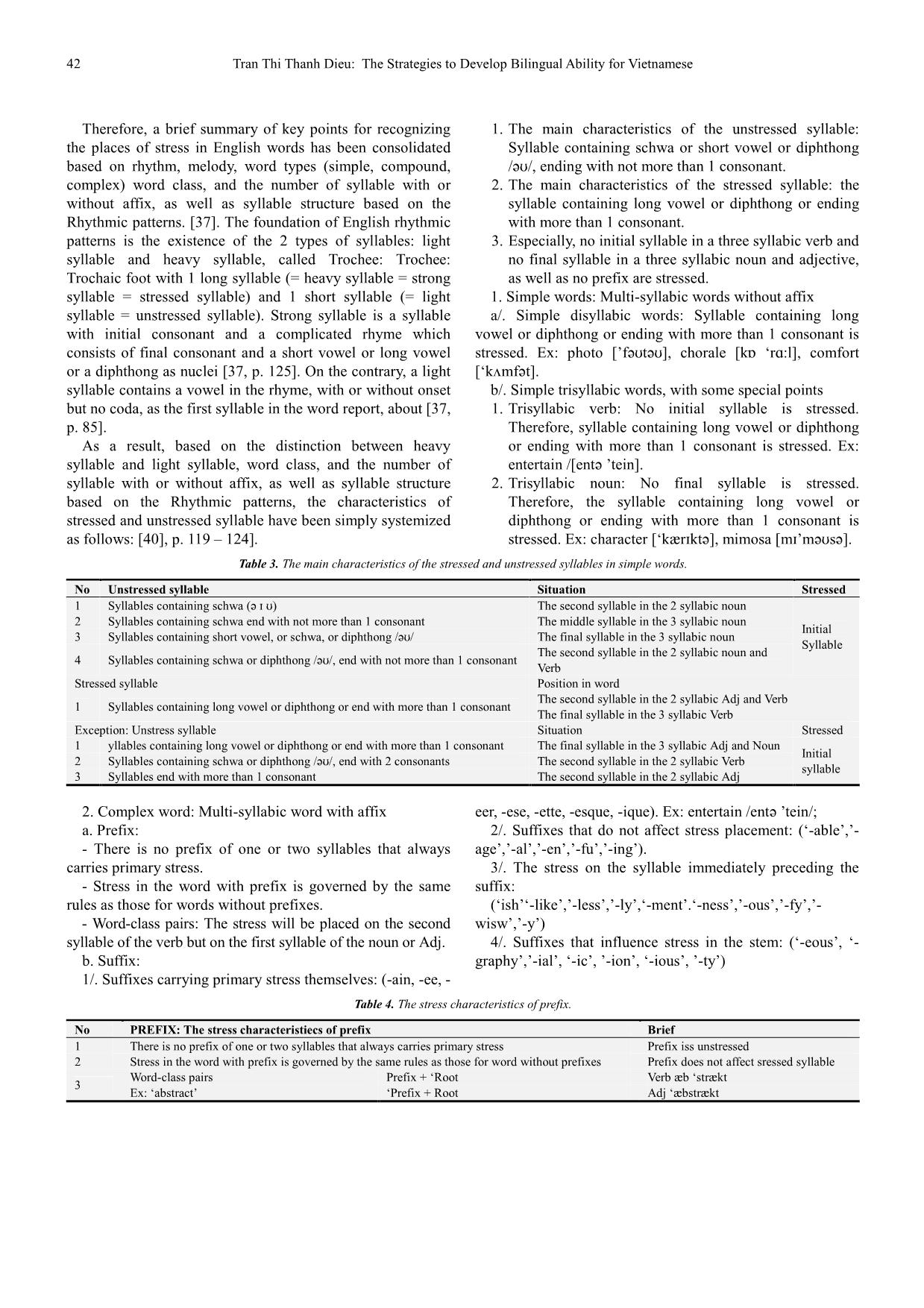
Trang 7
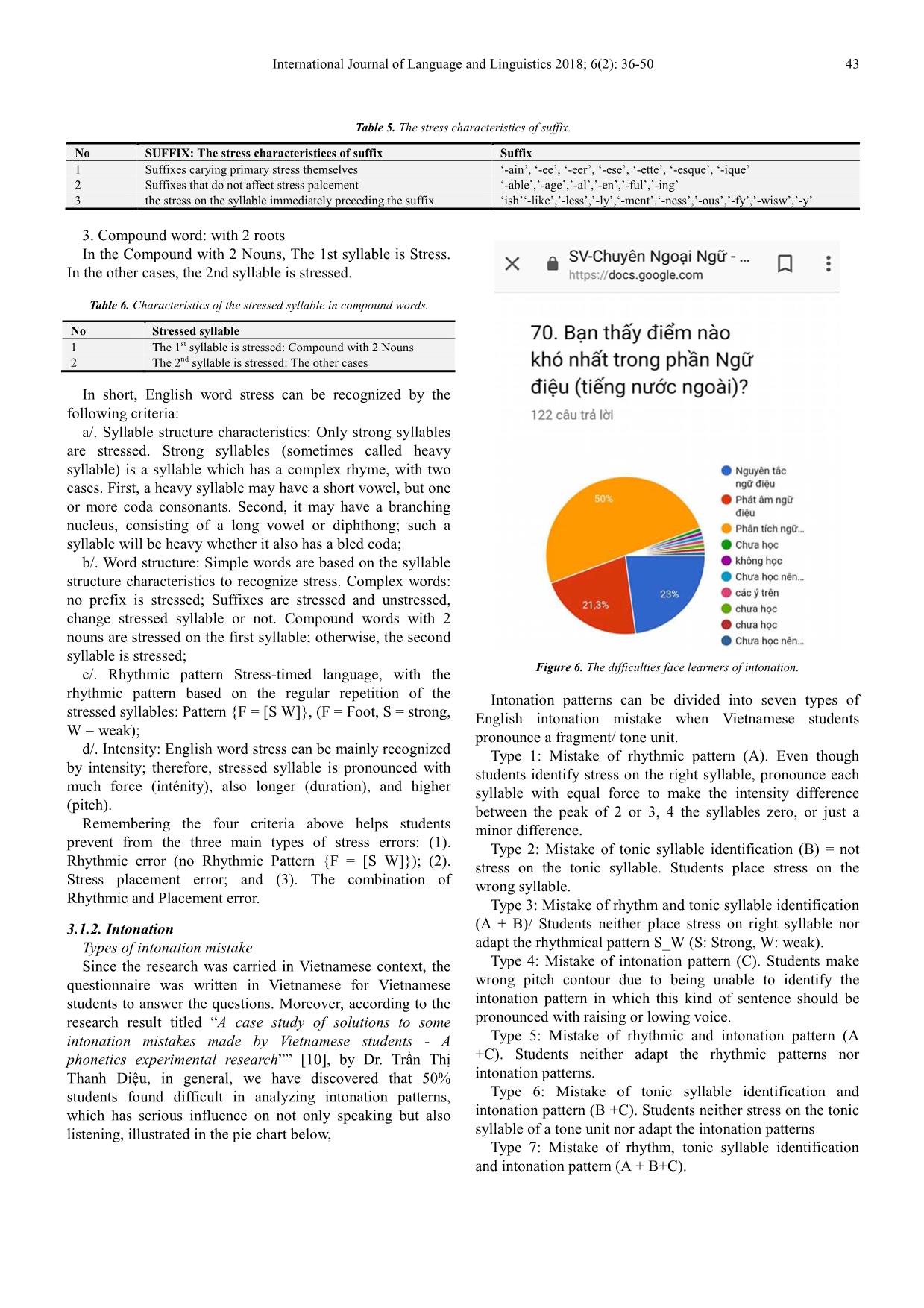
Trang 8
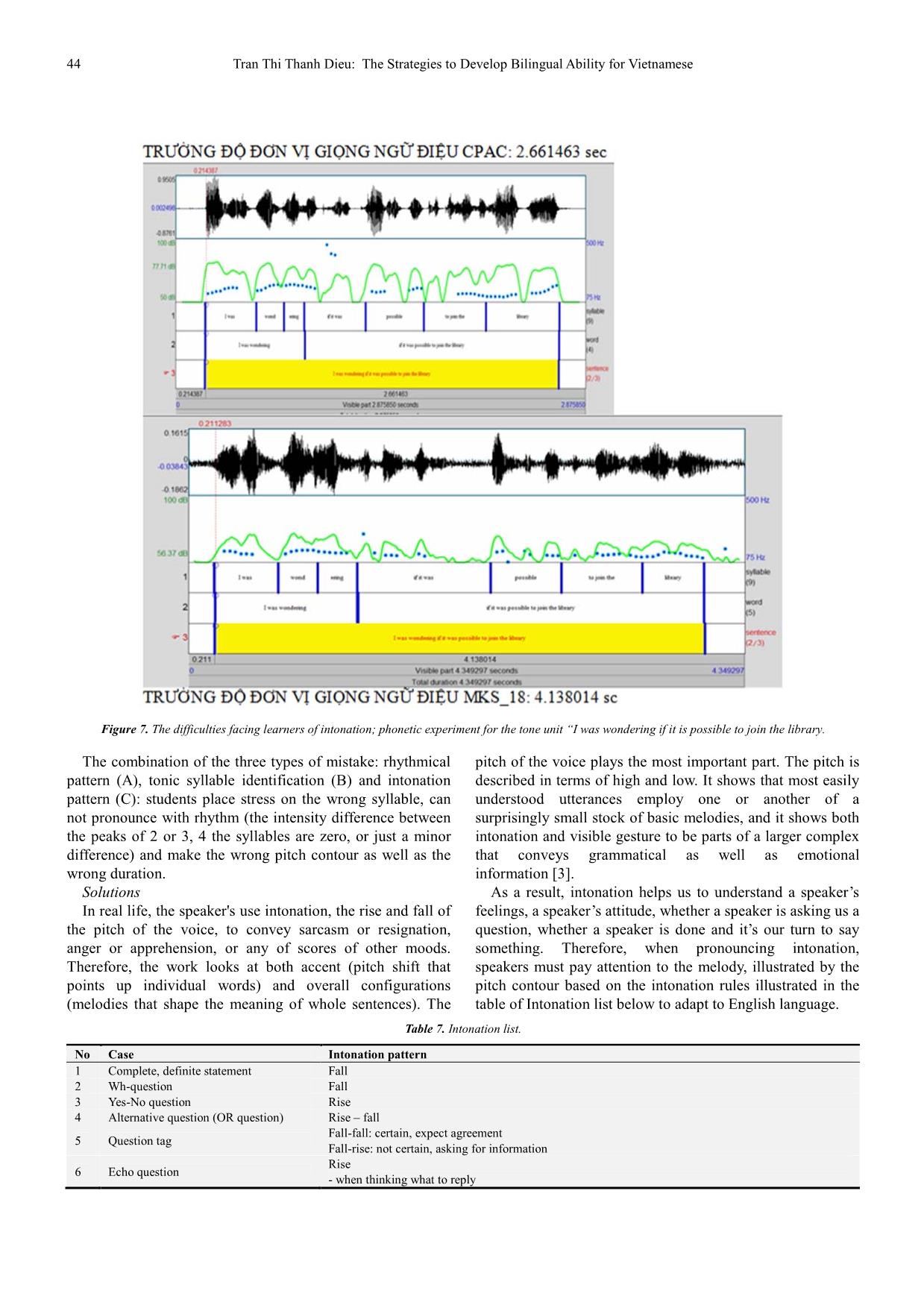
Trang 9
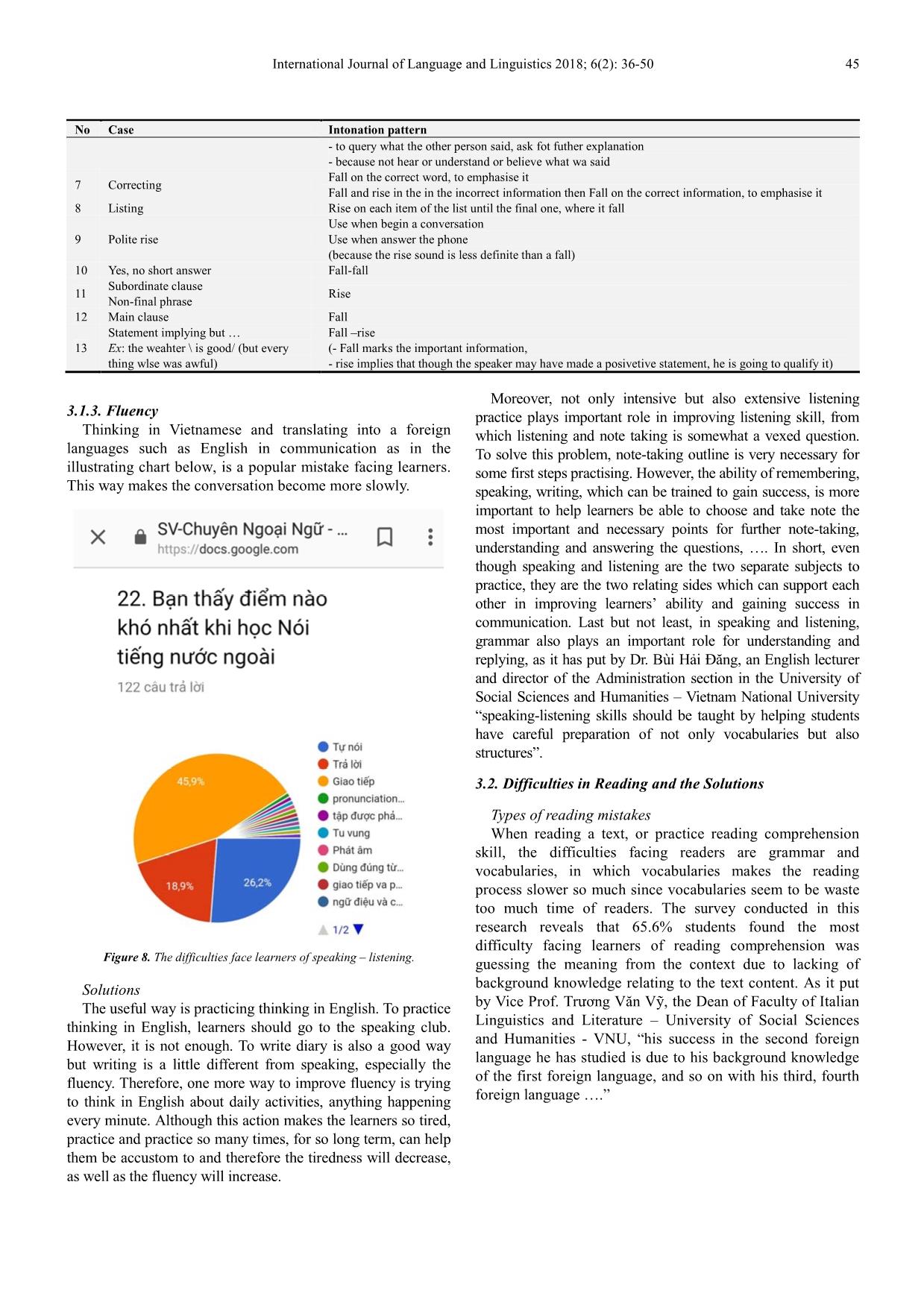
Trang 10
Tải về để xem bản đầy đủ
Tóm tắt nội dung tài liệu: The Strategies to Develop Bilingual Ability for Vietnamese
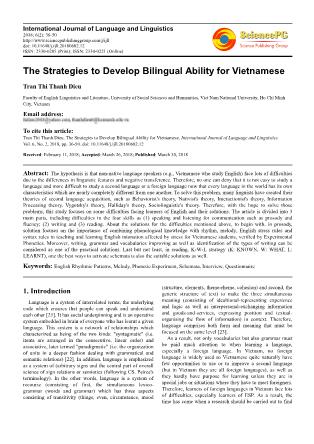
International Journal of Language and Linguistics 2018; 6(2): 36-50 doi: 10.11648/j.ijll.20180602.12 ISSN: 2330-0205 (Print); ISSN: 2330-0221 (Online) The Strategies to Develop Bilingual Ability for Vietnamese Tran Thi Thanh Dieu Faculty of English Linguistics and Literature, University of Social Sciences and Humanities, Viet Nam National University, Ho Chí Minh City, Vietnam Email address: To cite this article: Tran Thi Thanh Dieu. The Strategies to Develop Bilingual Ability for Vietnamese. International Journal of Language and Linguistics. Vol. 6, No. 2, 2018, pp. 36-50. doi: 10.11648/j.ijll.20180602.12 Received: February 11, 2018; Accepted: March 26, 2018; Published: March 30, 2018 Abstract: The hypothesis is that non-native language speakers (e.g., Vietnamese who study English) face lots of difficulties due to the differences in linguistic features and negative transference. Therefore, no one can deny that it is not easy to study a language and more difficult to study a second language or a foreign language now that every language in the world has its own characteristics which are nearly completely different from one another. To solve this problem, many linguists have created their theories of second language acquisition, such as Behaviorist's theory, Nativist's theory, Interactionist's theory, Information Processing theory, Vygotsky's theory, Halliday's theory, Sociolinguistic's theory. Therefore, with the hope to solve those problems, this study focuses on some difficulties facing learners of English and their solutions. The article is divided into 3 main parts, including difficulties in the four skills as (1) speaking and listening for communication such as prosody and fluency; (2) writing and (3) reading. About the solutions for the difficulties mentioned above, to begin with, in prosody, solution focuses on the importance of combining phonological knowledge with rhythm, melody, English stress rules and syntax rules in teaching and learning English intonation affected by stress for Vietnamese students, verified by Experimental Phonetics. Moreover, writing, grammar and vocabularies improving as well as identification of the types of writing can be considered as one of the practical solutions. Last but not least, in reading, K-W-L strategy (K: KNOWN, W: WHAT, L: LEARNT), one the best ways to activate schemata is also the suitable solutions as well. Keywords: English Rhythmic Patterns, Melody, Phonetic Experiment, Schemata, Interview, Questionnaire 1. Introduction Language is a system of interrelated terms, the underlying code which ensures that people can speak and understand each other [21]. It has social underpinning and is an operative system embedded in brain of everyone who has learnt a given language. This system is a network of relationships which characterized as being of the two kinds: "syntagmatic" (i.e. items are arranged in the consecutive, linear order) and associative, later termed "paradigmatic" (i.e. the organization of units in a deeper fashion dealing with grammatical and semantic relations) [22]. In addition, language is emphasized as a system of (arbitrary signs and the central part of overall science of sign relations or semiotics (following CS. Peirce's terminology). In the other words, language is a system of recourse (consisting of first, the simultaneous lexico- grammar (words and grammar) which has three aspects consisting of transitivity (things, even, circumstance, mood (structure, elements, theme-rheme, cohesion) and second, the generic structure of text) to make the three simultaneous meaning (consisting of idealtional-representing experience and logic as well as interpersonal-exchanging information and goods-and-services, expressing position and textual- organising the flow of information) in context. Therefore, language comprises both form and meaning that must be focused on the same level [23]. As a result, not only vocabularies but also grammar must be paid much attention to when learning a language, especially a foreign language. In Vietnam, no foreign language is widely used so Vietnamese quite naturally have few opportunities to use or to improve a second language (but in Vietnam they are all foreign languages), as well as they hardly have purpose for learning unless they are in special jobs or situations where they have to meet foreigners. Therefore, learners of foreign languages in Vietnam face lots of difficulties, especially learners of ESP. As a result, the time has come when a research should be carried out to find International Journal of Language and Linguistics 2018; 6(2): 36-50 37 out the difficulties facing Vietnamese learners of foreign languages, detailed in the topic “The lecturers and students’ ability and method to acquire the foreign languages”, with the scope is limited in Vietnam National University HCMC - Vietnam, from which “The strategies to develop the bilingual ability for Vietnamese in the multi-lingual communicative context have been systemized”, as the permission of carrying out the research from the University of Social Sciences and Humanities – Vietnam National University, written in the following decision document: Figure 1. Written dicision to allow the research done. The topic has been developed through the phonetic experimental research into prosody, especially English prosody, which has been considered as the most difficult in learning English; as well as the survey research through the collection of experiences in learning and teaching foreign languages, as well as difficulties facing students and lecturers, by the questionnaires and questions for interviewing lecturers and students in Vietnam National University. Moreover, the improvement of lesson plans, the solutions for the problems facing learners have been also systemized. In the end, so ... should base on the view: Zone of proximal Development (ZPD) of Vygotsky’s philosophy to check the result of learning process [12]. 4. Conclusion In brief, the research has been carried out to find out the difficulties facing Vietnamese learners of foreign languages, detailed in the lecturers and students’ ability and method to acquire the foreign languages, with the scope is limited in Vietnam National University HCMC, from which the strategies to develop the bilingual ability for Vietnamese in the multi-lingual communicative context have been systemized. From data analysis of the research, the lecturers and students in Vietnam National University HCMC have good ability to acquire the foreign languages to adapt the requirement from the University for working and graduating. Moreover, some lecturers are good at a foreign language enough to go abroad for teaching and researching. Therefore, all of them have their all method to acquire their foreign languages such as English, French, However, they also face some difficulties in common, from which the suitable strategies have been systemized to solve their problems for developing the bilingual ability for Vietnamese in the multi- lingual communicative context, briefly classified as difficulties in the four skills: speaking – listening, reading and writing, as follows: In the field of speaking and listening, based on the questionnaire result, the most difficulties facing learners is stress level identification, analyzing intonation patterns, fluency caused by translating from mother tongue into a foreign language. From the phonetic experiment, three types of English stress mistakes has been recognized as Rhythmic error, Wrong placement of stress and combination of these two types; and seven types of intonation mistakes are also summarized as rhythmic pattern, tonic syllable identification and combination in pair and in set. Therefore, English word International Journal of Language and Linguistics 2018; 6(2): 36-50 49 stress can be recognized by the following criteria: Syllable structure characteristics, Word structure, Rhythmic pattern, and Intensity. Moreover, when pronouncing intonation, speakers must pay attention to the melody, illustrated by the pitch contour based on the intonation rules. In addition, thinking in Vietnamese and translating into a foreign language such as English in communication is a popular mistake that makes the conversation become more slowly. As a result, the useful way is practicing thinking in English by some techniques illustrated in the findings of this research. Moreover, not only intensive but also extensive listening practice plays important role in improving listening skill, from which listening and note taking is somewhat a vexed question. To solve this problem, note-taking outline, the ability of remembering, speaking, writing, are very necessary for improving listening skills. Therefore, no-one can deny that even though speaking and listening are the two separate subjects to practice, they are the two relating sides which can support each other in improving learners’ ability and gaining success in communication. In the field of reading comprehension, the difficulties facing readers are grammar and vocabularies, in which vocabularies makes the reading process slower, as well as the problem with guessing the meaning of the words from the contexts. Therefore, to guess the meaning from context, readers can base on the meaning of vocabulary items that surrounds it; the way the word is formed; background knowledge of the subject and the situation. As a result, the word relation, the structure relation, the part of speech, the word form are the important factors leading to successful guessing meaning of words based on the contexts. Beside that, the most difficulty facing learners of grammar was applying the theories to do the exercises, to real life. One of the reasons is that students do not remember the grammar rules, the theories. Therefore, learning by heart grammar structure is also necessary. In addition, when doing the reading comprehension, pay much attention to the grammar points used in the reading texts to understand grammar used in real contexts. From the importance of grammar mentioned above, teacher should teach their students a system of grammar knowledge enough in comparison with their mother tongue to avoid from negative transference mistake, for them to practice all the 4 skills before help students to practice any skills. As it put by Ms. Lê Ngọc Báu (MA), the French Lecturer in the Faculty of French Linguistics and Literature- University of Social Sciences and Humanities – VNU, Ms. Nguyễn Minh Thúy (MA), the Chinese Lecturer in the Faculty of Chinese Linguistics and Literature - University of Social Sciences and Humanities – VNU, and Mr. Võ Duy Minh (MA), the English Lecturer in the Faculty of English Linguistics and Literature - University of Social Sciences and Humanities – VNU, that they always improve their lesson plan after every semester in comparison with the mother tongue, Vietnamese to help students prevent form negative tranference mistakes. Beside that, the appropriateness of this method has been proved through my 30-year-teaching life, and has been applied with a certain success at my Center of Foreign language, named Sa Phi Foreign Language Center – Sapphire. Ltd, located in Vietnam, 57 Bùi Đình Túy Str, Ward 24, Bình Thạnh District. In the field of academic writing, the popular problems are identifying wrong types of writing, writing ungrammatically, writing incoherently and lacking of vocabularies, as well as combination of these mistakes. To solve these problems, teachers should teach students how to develop a paragraph which consists of a topic sentences, some supporting sentences such as explanation, statistics, as well as to distinguish among the ways to develop a narrative, argumentative, cause-effect . paragraphs/ essays. Beside that, to have enough words for a piece of writing, students should pay attention to the following ways: (1) Accumulating vocabularies from the reading texts. (2) Accumulating vocabularies from preparing for writing. (3) Accumulating vocabularies from preparing for speaking topic. (4) Making plan to cumulate vocabularies [17]. Last but not least, from the problems and solutions mentioned above, an improved teaching method has been raised as the K-W-L strategies to activate background knowledge before beginning writing or reading the text or any fields. K-W-L is a thinking-reading process, with three steps: K (What we know), W (What we want to find out, and L (What we learned and still need to learn). This procedure can help learners to access the knowledge they already have about the topic or make it available appropriately so that comprehension can occur: The last word is that even though this research has not been able to cover all the problems facing learners of languages, these raised here should be considered as the popular and serious that must be solved to help learners be successful in studying and using a language, especially when it is not a mother tongue. Therefore, the research is always opened for adding new recognition of mistakes made by learners and their solutions, as well as any experiences from learners and teachers of languages. References [1] Anderson, John M.; and Ewen, Colin J. (1987). Principles of dependency phonology. Cambridge University Press. [2] Aoyama, K. & S. Guion. (2007). Prosody in second language acquisition. Acoustic analyses of duration and FO range. In O.-S. Bohn & M. Munro, eds. Language experience in second language speech learning. In honor of James Emil Flege, John Benjamins: 281–297. [3] Bolinger, D. (1985). Intonation and Its Parts, Melody in Spoken English. Standford University Press. [4] Brentari, Diane. (1998). A prosodic model of sign language phonology. Cambridge, MA: MIT Press. [5] Nguyễn Tài Cẩn. (1997). Giáo trình lịch sử ngữ âm tiếng Việt. Nxb Giáo dục. [6] Chomsky N and Halle M. (1968). The sound pattern of English. New York: Harper & Row. 50 Tran Thi Thanh Dieu: The Strategies to Develop Bilingual Ability for Vietnamese [7] Clements, George N. (1985). The geometry of phonological features. Phonology Yearbook, 2, 225-252. [8] Clements, George N.; and Samuel J. Keyser. (1983). CV phonology: A generative theory of the syllable. Linguistic inquiry monographs (No. 9). Cambridge, MA: MIT Press. ISBN 0-262-53047-3 ISBN 0-262-03098-5. [9] De Lacy, Paul, The Cambridge Handbook of Phonology. Cambridge University Press. ISBN 0-521-84879-2 (hbk), 2007. [10] Trần Thị Thanh Diệu. (2015). A case study of solutions to some intonation mistakes made by Vietnamese students A phonetics experimental research. International Journal of Language. Vol. 3, No. 2, 2015. pp. 52-60. ISSN: 2330-0221. [11] Trần Thị Thanh Diệu. (2017). Some stress mistakes and solutions, a phonetic experimental research on Vietnamese students. International Journal of Language. Vol. 3, No. 2, 2017. pp. 52-60. ISSN: 2330-0221. [12] Trần Thị Thanh Diệu. (2015). A Some Vietnamese Viewpoints upon Second Language Acquistion Theories in Language Contact Environment. International Journal of Language and Linguistics USA ISSN 2330-0221 2015; 5 (2). [13] Trần Thị Thanh Diệu. (2016). Trying K-W-L Strategy on Teaching Reading Comprehension to Passive Students in Vietnam. International Journal of Language and Linguistics USA ISSN 2330-0221 2016; 1 (2). [14] Trần Thị Thanh Diệu. (2012). Hiện tượng liên ngữ tiếng Anh ở sinh viên người Việt. Tạp chí Tự điển học và Bách Khoa Thư – ISSN 1859-3135 – Số 3 (17), tháng 5 - 2012 [15] Trần Thị Thanh Diệu. (2012). Phonetic experimental research into the acquisition of English stress through rhythm by Vietnamese students. Tạp chí Khoa học Công Nghệ Giao thông Vận tải - ĐHGTVT TP.HCM – ISSN 0866-7020 – Số 2- 04/ 2012 [16] Trần Thị Thanh Diệu. (2012). Cách xác định trọng âm từ tiếng Anh đối với sinh viên Việt Nam. Tạp chí Ngôn ngữ Đời sống - ISSN 0868-3409 – Số 6 - 06/ 2012 [17] Trần Thị Thanh Diệu. (2017). English – Japanese language and literature, some relation. LAP LAMBERT Academic Publishing - ISBN-10 3330344520. ISBN-13 978- 3330344525 – July 5th 2017 [18] Dornyei, Z. (2003). Questionnaires in Second Language Research. IEA. [19] Duff, P, A. (2007). Case Study Research in Applied Linguistics. IEA. [20] Nguyễn Công Đức, Nguyễn Hữu Chương. (2004). Từ vựng tiếng Việt. Tủ sách Đại học Khoa học Xã hội và Nhân văn. [21] Fromkin V, Roadman, Collins & Blairs. An Introduction to Language. Second Australian Edition, 1990. [22] Fromkin V, Roadman R, Hyams N. An Introduction to Language. Nineth American Edition: Wadsworth Cengage learning, Canada, 2011. [23] Fromkin V, Roadman R, Hyams N. An Introduction to Language. Seventh American Edition, 2003. [24] Fry D. B. (1955). Duration and intensity as physical correlates of linguistic stress. J. Acoust. Soc. Am. 27, 765– 768. doi: 10.1121/1.1908022. [25] Fry D. B. (1958). Experiments in the perception of stress. Lang Speech 1, 126–152. [26] Fry D. B. (1965). The dependence of stress judgments on vowel formant structure. in Proceedings of the 5th International Congress of Phonetics Sciences, eds. Zwerner X., and Bethge W., Karger: Basel, pp. 306–311. [27] Nguyễn Thiện Giáp. (2009). Các phương pháp nghiên cứu ngôn ngữ. Nxb Giáo dục. [28] Goldsmith, John A. (1995). “Phonological Theory” in John A. Goldsmith. The Handbook of Phonological Theory. Blackwell Handbooks in Linguistics. Blackwell Publishers. [29] Goldsmith, John A. (1979). The aims of autosegmental phonology. In D. A. Dinnsen (Ed.), Current approaches to phonological theory. Bloomington: Indiana University Press. [30] Griffee D. T. & Nunan D. (1997). Classroom Teachers and Classroom research. Tokyo, Japan: The Japan Association for Language Teaching. [31] Hadley G. (2003). Action Research in Action. Singapore: SEAMEO Regional Language Center. [32] Cao Xuân Hạo. (2006). Tiếng Việt, mấy vấn đề Ngữ âm, Ngữ pháp, Ngữ nghĩa. Nxb Khoa học Xã hội. [33] Hatch E and Lazaraton A, University of California. (1991). The Research Manual Design and Statistics for Applied Linguistics. Boston: Heinle & Heinle Publishers A Division of Wadsworth, Inc Boston, Massachusetts 02116. [34] Nguyễn Quang Hồng. (2002). Âm tiết và loại hình ngôn ngữ. Nxb Đại học Quốc gia Hà Nội. [35] Jones D. (2002). The pronunciation of English. Cambridge University Press. [36] Ladefoged, Peter. (2001). A Course in Phonetics (4th ed.). Boston: Heinle & Heinle, Thomson Learning. [37] McMahon A. (1988). An Introduction to English Phonology. Edinburgh Univiersity Press. [38] Plonsky, L. (2015). Advancing Quantitative Methods in Second Language Research. Roughlet, Newyork and London. [39] Richards, R, C. (1973). Error Analysis – Perspectives on Second Language acquisition. Longman. [40] Roach, P. (1998). English Phonetics and Phonology. The Youth Press, Vietnam. [41] SEAMEO Regional Language Center. (2003). Research Methodology Singapore: SEAMEO Regional Language Center. [42] Spencer, A. (1991). Morphological Theory. Cambridge University Press. [43] Stump, G, T. (2001). Inflectional Morphology – A theory of Paradigm Structure. Cambridge University Press. [44] Lê Quang Thiêm. (2004). Nghiên cứu đối chiếu các ngôn ngữ. Nxb Đại học Quốc gia Hà Nội. [45] Đinh Lê Thư, Nguyễn Văn Huệ. (1998). Cơ cấu ngữ âm tiếng Việt. Nxb Giáo dục. [46] Đòan Thiện Thuật. (1980). Ngữ âm tiếng Việt. Nxb Đại học và Trung học chuyên nghiệp.
File đính kèm:
 the_strategies_to_develop_bilingual_ability_for_vietnamese.pdf
the_strategies_to_develop_bilingual_ability_for_vietnamese.pdf

